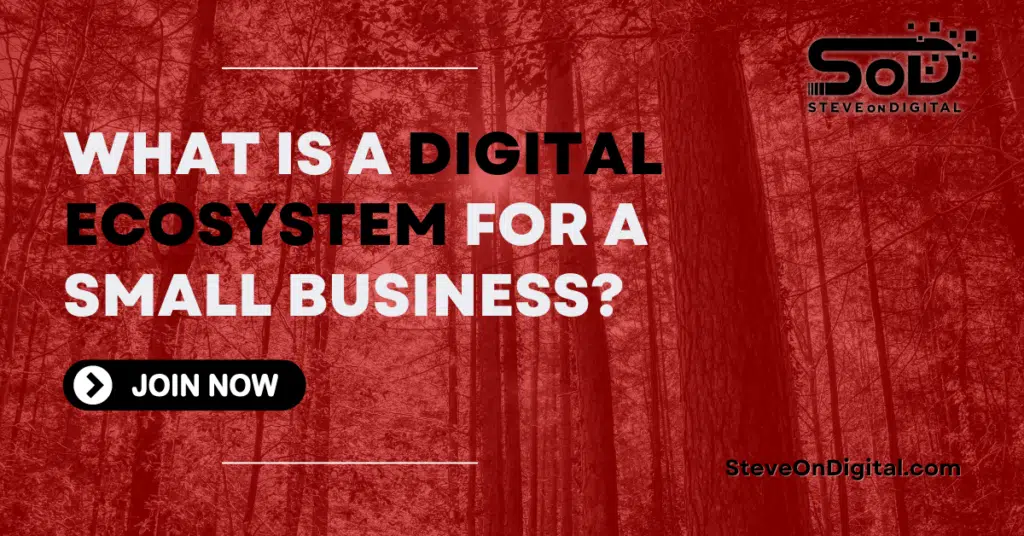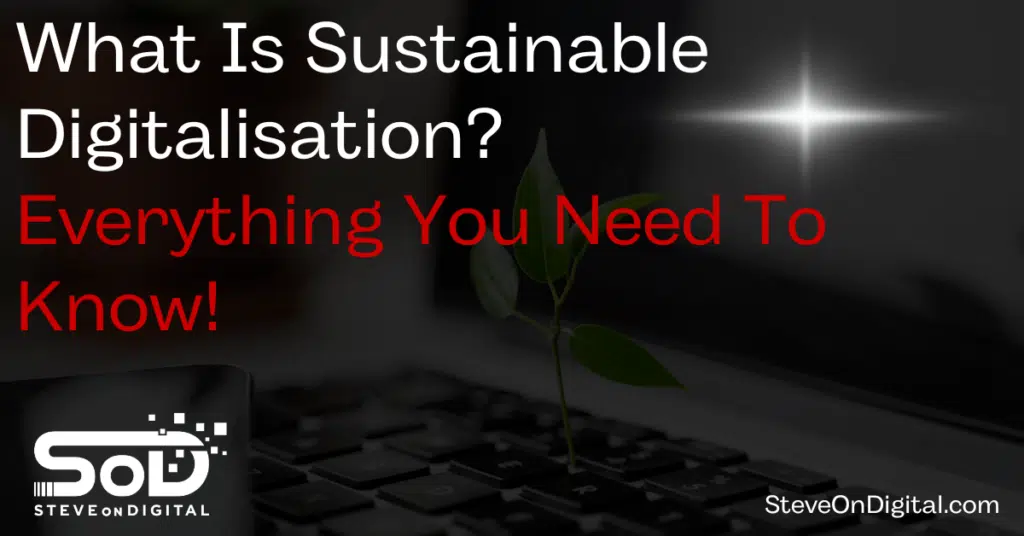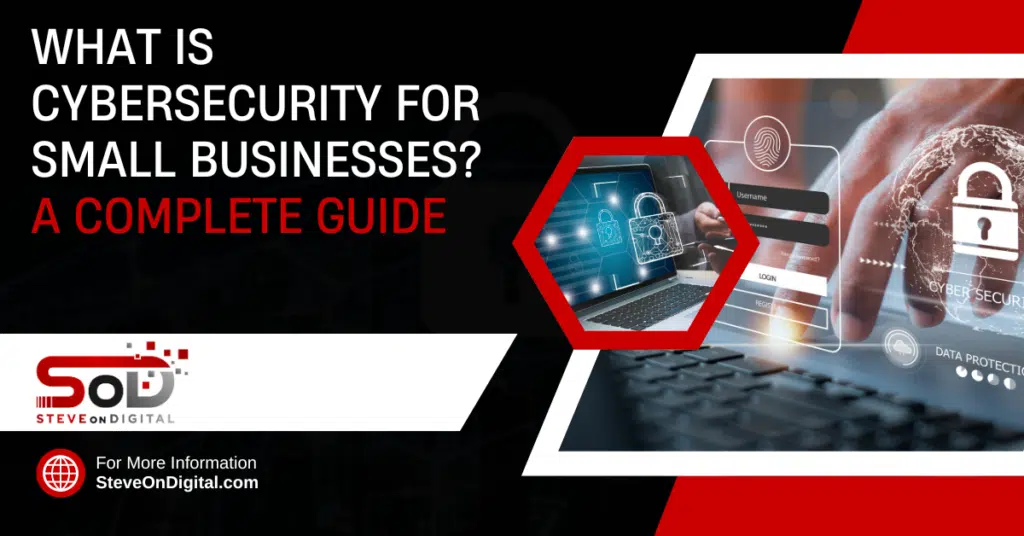What Is A Digital Ecosystem For A Small Business? | SOD

A digital ecosystem for a small business is a network of interconnected digital technologies that enhances operations and customer interactions. It integrates various tech elements to streamline processes and improve engagement efficiently. As a Digital Transformation Specialist, I, Steve Johnston, utilize my extensive background in electrical engineering, an MBA, and a master’s in Project Management to guide over a million business owners and IT directors through the digital landscape. With my profound commitment to family and continuous learning, I leverage my presence on platforms like YouTube and LinkedIn to share valuable insights tailored for small and medium-sized enterprises. My expertise is reflected in the practical advice and content I provide, aimed at addressing the unique digital challenges faced by SMEs today. Unveiling The Digital Ecosystem Concept As a digital transformation specialist, I’ve observed firsthand the transformative impact a well-structured digital ecosystem can have on a small business. A digital ecosystem isn’t just a buzzword; it’s a comprehensive framework that enables businesses to thrive in an increasingly digital world. A business ecosystem, as an integral part of this digital ecosystem, plays a pivotal role in enhancing operational efficiency and customer engagement through interoperability and innovation, ensuring seamless communication and collaboration. Defining A Digital Ecosystem A digital ecosystem, in its essence, refers to a network of interconnected digital technologies and platforms that businesses leverage to enhance operational efficiency and customer engagement. This ecosystem integrates various elements of technology to create a cohesive environment where data and processes coexist seamlessly and effectively. It’s about making technology work for you in the most integrated and efficient way possible. Moreover, the digital ecosystem model emphasizes that such scalability and customization are not exclusive to large enterprises. Small and medium businesses can also benefit significantly from adopting digital ecosystem models, tailoring them to meet their unique needs and objectives, ensuring operational efficiency and enhanced customer engagement across all sizes of businesses. Core Components Impact Of Digital Ecosystems Throughout my journey with SteveOnDigital, I’ve implemented numerous digital ecosystems for small and medium enterprises (SMEs). One of the key lessons I’ve learned is the importance of choosing the right components that not only align with your business objectives but also enhance your capability to manage customer relationships and operations efficiently. This strategy not only supports growth but also builds a resilient infrastructure capable of adapting to new challenges and opportunities in the digital age. The Strategic Importance Of Digital Ecosystems Understanding the value of digital ecosystems has been crucial in my journey with SteveOnDigital. I’ve seen firsthand how these systems are indispensable for small businesses looking to gain a competitive edge and achieve sustainable growth. The integration of digital technologies into your business operations isn’t just about keeping up with trends—it’s about setting the foundation for future success. In exploring the dynamics of digital ecosystems, it’s essential to understand the various business models they encompass, such as functional digital ecosystems, platform ecosystems, and super platform ecosystems. These models illustrate how businesses can leverage digital ecosystems to create and capture value, detailing revenue generation, the partners involved, and providing examples of companies successfully implementing these strategies. Equally important is the evolution from traditional business models. As digital ecosystems redefine the relationships between clients, customers, and businesses, there’s a pressing need for businesses to rethink and reshape their approaches. Moving beyond the sole aim of maximizing profits, adopting a new attitude towards collaboration within ecosystems is crucial for thriving in the digital age. Advantages For Small Businesses In my experience, the most immediate benefit of implementing a digital ecosystem is the dramatic improvement in operational efficiency. By automating processes and minimizing manual tasks, businesses can focus more on strategic activities that drive growth. For instance, using digital tools to manage inventory or streamline customer communications can save countless hours and reduce errors, which directly translates into cost savings. Another significant advantage is the expanded market reach. Digital ecosystems enable small businesses to operate on a global scale without the need for physical expansion. With the right digital platform, even a small local shop can reach customers worldwide, providing opportunities that were once exclusive to larger corporations. Customer loyalty is also enhanced through digital ecosystems. Benefit Description Enhanced Customer Experience Integrates various touchpoints for a smoother, personalized customer journey. Operational Efficiency Automates routine tasks, freeing up time for strategic activities. Access to New Markets Enables global reach without the need for physical expansion, using digital platforms. Cost Efficiency Reduces operational costs by streamlining processes and reducing manual labor. By creating more touchpoints and facilitating easier interactions, businesses can build stronger relationships with their customers. Personalized marketing, powered by customer analytics, allows businesses to offer tailored solutions that meet individual needs and preferences, fostering a sense of loyalty and increasing customer retention. The Role Of Data Analytics Data analytics, bolstered by digital technology, is the cornerstone of any successful digital ecosystem. In my role, leveraging data analytics and digital technology has not just been about collecting data but transforming it into actionable insights that drive decision-making and innovation. For example, understanding customer behavior patterns through digital technology helps tailor marketing strategies that resonate more effectively with target audiences. Effective use of data analytics, enhanced by digital technology, also involves optimizing operations for efficiency. Through real-time data monitoring enabled by digital technology, businesses can identify bottlenecks in their operations and adjust processes accordingly. This dynamic approach, powered by digital technology, ensures that the business remains agile and can respond quickly to changing customer behaviors, market trends, and internal challenges, thereby improving their ecosystem strategies. Building Your Digital Ecosystem Developing a functional digital ecosystem is like constructing a house; it requires careful planning, the right tools, and a clear understanding of the end goal. As I’ve worked with various small businesses through SteveOnDigital, the success of digital transformation projects often hinged on meticulous alignment with business objectives and the strategic selection of technologies. Here’s a breakdown of how to build your digital ecosystem effectively. Aligning With Business Objectives One of the first steps
What Is Sustainable Digitalisation? | Everything You Need To Know!

Hi, I’m Steve Johnston, your guide through the transformative world of sustainable digitalisation. What does this mean? Simply put, sustainable digitalisation is the integration of digital technology into sustainability efforts. This combination aims to achieve environmental, social, and economic benefits simultaneously. As a digital transformation specialist with a background in electrical engineering and extensive experience in project management, I’ve witnessed first-hand how technology can spearhead monumental changes, not just in businesses but in the very fabric of society. Today, let’s set the stage for understanding why this integration is crucial in our current technological landscape. Exploring the Fundamentals Defining The Concept And Core Principles Sustainable digitalisation isn’t just a buzzword; it’s a pivotal strategy in facing today’s environmental and technological challenges. It involves what I like to call the twin transition—marrying digital and environmental transformations to forge a path that’s not only innovative but also conscious of our planet’s health. The core principles of sustainable digitalisation include: In my journey with small and medium-sized businesses (SMEs), I’ve employed digital solutions that not only boost efficiency but also reinforce sustainability. It’s not just about being better; it’s about being responsible and foresighted. Digital Technologies Driving Sustainability The role of digital technologies in driving sustainability is more significant than ever. Here are a few ways how: As we continue to advance in the digital age, it’s crucial to harness these technologies not just for economic growth but for a sustainable future. In my role, I’ve guided many SMEs to integrate these digital tools effectively, ensuring they contribute positively to global sustainability efforts. Benefits Of Sustainable Digitalisation Environmental Impact As we continue our exploration of sustainable digitalisation, it’s vital to understand its profound environmental benefits. Digital solutions like smart grids and precision agriculture are pivotal in transforming how we use our natural resources, ultimately supporting our environmental goals. As someone deeply embedded in the digital transformation landscape, I’ve seen these technologies first-hand: Such technologies not only help in reducing resource consumption but also contribute to a sustainable future by lessening the ecological footprint of digital activities. Social And Economic Advantages The impact of sustainable digitalisation extends beyond environmental benefits; it also encompasses significant social and economic advantages. Here’s how digital tools are revolutionizing access to essential services and fostering economic growth: Addressing Challenges In Sustainable Digitalisation Bridging The Digital Divide One of the critical challenges in sustainable digitalisation is ensuring that it is inclusive. The digital divide—the gap between those who have access to digital technologies and those who do not—remains a significant barrier. Here are a few ways we can bridge this divide: As a member of an incubator board, I advocate for these initiatives, emphasizing that digital access is a right, not a privilege. Managing Energy And Resource Demands The increase in digital activities brings its own set of challenges, notably in managing the energy and resources they demand. Here are some strategies to balance these demands with energy-efficient solutions: Through concerted action and commitment to these strategies, we can manage the ecological impacts of our digital transformation. It’s not just about adopting new technologies but doing so in a way that respects and preserves our natural environment for future generations. Case Studies And Real-World Applications Success Stories In Sustainable Digital Transformation As we dive deeper into the impact of sustainable digitalisation, it’s inspiring to look at real-world success stories. These case studies not only showcase the potential of digital technologies but also demonstrate the tangible benefits of sustainable digital transformation. These initiatives highlight not just innovation but also a commitment to environmental goals and sustainable practices that benefit society as a whole. Corporate Initiatives Towards Digital Sustainability Leading companies worldwide are not just adopting digital solutions; they are integrating sustainable practices into their digital strategies. This approach reflects a robust commitment to corporate responsibility and sustainable development. These examples underscore how companies can assume social responsibility and leverage digital innovation to promote sustainability and economic growth. Future Directions For Sustainable Digitalisation Innovations Shaping Sustainable Digital Futures Looking forward, the evolution of digital tools and technologies is poised to dramatically shape sustainable practices. Here are a few innovations that are on the horizon: These technological advancements are paving the way for a more sustainable and efficient future, proving that the digital revolution is integral to global sustainability. The Twin Transition: Climate And Digital Transformation The concept of the twin transition refers to the dual focus on addressing both the climate crisis and digital transformation. This transition represents both a challenge and an opportunity: In my role as a digital transformation specialist, I’ve seen how embracing this twin transition can drive not just technological advancements but also significant environmental and social improvements. It’s about ensuring that our journey towards a digital age also steers us towards a sustainable future, leveraging digital solutions to build a world that’s better for all. Empowering Through Knowledge And Skills Enhancing Digital Skills For A Sustainable Future In the journey toward sustainable digitalisation, one of the most crucial steps is enhancing digital skills across all levels of society. This commitment to education and training ensures that everyone, from young students to seasoned professionals, can participate effectively in the digital economy. Here’s why building these skills is essential: Skill Area Description Importance in Sustainability Data Analysis Ability to interpret and derive meaningful insights from data. Crucial for optimizing resource use and improving sustainability metrics. Artificial Intelligence Knowledge of AI applications to automate and optimize processes, reducing energy consumption. Enhances efficiency and decision-making in sustainable practices. Cybersecurity Skills to protect and secure data, ensuring privacy and integrity in digital operations. Essential for safe digital transformations and maintaining trust. Blockchain Technology Understanding blockchain for transparency and secure data transactions. Supports sustainability in supply chains and enhances accountability. Empowering people with the right skills leads to more innovative and effective solutions in sustainable digital transformation, fostering a workforce that is not only tech-savvy but also environmentally conscious. Data-Driven Decision Making For Sustainability Data is at the heart of modern digitalisation
Why Is Data Important For Your Business? | The Real Truth

Hello, I’m Steve Johnston from SteveOnDigital, and today we’re diving into why data is foundational for any business looking to thrive in today’s fast-paced market. Across industries, data has transitioned from a nice-to-have to an absolutely essential asset. It drives strategic decisions, refines business processes, and directly impacts the bottom line. Through my journey as a Digital Transformation Specialist, I’ve witnessed first-hand how the power of good data transforms SMEs. Here’s a closer look at why data is so pivotal. Data not only provides a clear understanding of where your business stands but also unveils pathways to where it could go. It’s about collecting data, both internal data and external data, and analyzing it to better understand your market conditions, consumer behavior, and operational efficiency. In this post, I’ll share insights on how leveraging data can grant your business a competitive edge, make your operations more efficient, and help you make informed decisions that drive growth. Unpacking The Value Of Customer Data Customer data is gold in the digital economy. Every interaction your customers have with your business, from browsing your website to completing a transaction, generates valuable data. By analyzing customer information, such as demographic details, purchasing habits, and social media activity, businesses can gain actionable insights. For instance, in my experience working with SMEs, I’ve helped businesses tailor marketing efforts by harnessing marketing data and customer feedback to create personalized customer experiences. This not only boosts customer retention but also increases revenue. One particular case involved a small retailer who, by leveraging customer data through predictive analytics, was able to optimize their stock levels and manage inventory more effectively, significantly reducing costs. Moreover, the strategic planning of marketing campaigns becomes more targeted with access to rich customer data. For example, understanding customer preferences helps tailor advertising retargeting, which in turn enhances the effectiveness of marketing dollars spent. This approach not only cuts costs but also increases the efficiency of marketing efforts, ensuring that every penny counts. Data Analysis Data analysis acts as the backbone for strategic decision-making in any business. With the right tools and techniques, raw data is transformed into insights that can guide key business decisions and strategies. In my role, I often guide businesses in setting up systems to analyze data effectively, ensuring that they can respond swiftly to changing market conditions and consumer needs. Tools like business intelligence software and data analytics platforms play a crucial role here. They allow businesses to process large volumes of data—big data—to unearth patterns and trends that are not visible to the human eye. This kind of analysis leads to better informed decisions, enhances business performance, and can even help in developing new business models. For example, through data driven insights gathered from sales and customer interactions, a business can refine its product performance and make smarter decisions about which new services to launch. In one instance, by analyzing sales data and customer feedback, a business I worked with could adjust its product offerings to better meet the needs of its consumers, significantly boosting sales and customer satisfaction. Optimizing Business Operations Through Data-Driven Processes In my years guiding SMEs through digital transformations, I’ve seen firsthand how data-driven processes are pivotal for streamlining operations and enhancing productivity. Here’s how businesses can utilize data analytics to not only boost efficiency but also substantially cut costs. Let me share a personal example. In one of the projects, by implementing a data-driven approach to manage inventory, we helped a client reduce overstock and avoid stockouts. This optimization led to a 20% reduction in inventory costs, showcasing how analyzing data can lead directly to significant financial savings. Risk Management And Security The role of data in risk management cannot be overstated. Data helps business owners anticipate potential risks and implement strategies to mitigate them effectively. Here’s how data fortifies a business’s defenses: From my experience, a clear understanding of risk management through data has enabled companies I’ve worked with to not just survive but thrive amid uncertainties. By analyzing historical data and market conditions, we’ve developed strategies that shield businesses from potential financial and operational risks. Competitive Advantage Through Strategic Data Use In today’s rapidly changing business environment, maintaining a competitive edge is more challenging and crucial than ever. Here’s how businesses leverage both internal data and external data to stay ahead of the competition: Leveraging Big Data And Predictive Analytics For Future Planning In the realm of digital transformation, big data and predictive analytics have become essential tools for businesses looking to stay ahead. As a Digital Transformation Specialist, I’ve seen these tools in action, helping businesses forecast market trends and anticipate customer needs with remarkable accuracy. Here’s how leveraging these technologies can enhance your strategic planning and decision-making processes. From personal experience, utilizing big data and predictive analytics in strategic planning has enabled the companies I’ve advised to not only mitigate risks but also discover lucrative opportunities for growth. For example, a retail client used predictive models to forecast seasonal fluctuations and adjust their inventory and marketing strategies accordingly, which significantly boosted their sales and customer satisfaction. Benefit Description Improved Demand Forecasting Predictive models analyze historical sales data to accurately forecast future demand and manage inventory. Enhanced Customer Insights Analyzing customer behavior patterns helps predict future buying habits and preferences. Risk Reduction Identifies potential risks in business operations and market trends, allowing for preemptive actions. Operational Efficiency Optimizes business operations by predicting peak operation times and resource requirements. Marketing And Sales The impact of data on marketing and sales strategies cannot be overstated. In today’s data-driven world, the ability to analyze customer information and marketing data has transformed how businesses approach sales and marketing. Here’s how data-driven insights are making a significant impact: An example from my consultancy practice involved assisting a client in enhancing their online advertising retargeting strategy through detailed analysis of consumer behavior and purchase history. The result was a 30% increase in conversion rates, demonstrating the power of informed, data-driven decision making in marketing and sales.
5 Principles Of Sustainable Business | SteveOnDigital

As Steve Johnston, owner and author of SteveOnDigital, I’ve dedicated significant time to understanding the evolving landscape of sustainability in business. This isn’t just about trends; it’s about a fundamental shift in how businesses operate in a world that’s increasingly conscious of its environmental and social footprint. Here, I’ll break down what sustainable business means and why it’s crucial not only for the planet but also for the profitability and reputation of businesses like yours. Definition And Significance A sustainable business operates on principles that reduce its environmental impact, contribute positively to society, and manage resources in a way that ensures long-term economic health. But what does this mean in practice? It means integrating strategies that support the natural environment, respect social values, and achieve economic efficiency—all without compromising the ability of future generations to meet their needs. The critical role of the private sector in driving sustainability and addressing global challenges such as climate change and social inequality cannot be overstated, emphasizing the collective responsibility of businesses in achieving a sustainable future. The relevance of sustainable business has skyrocketed, influenced heavily by global issues such as climate change and social inequality. As a small business owner, embracing these principles isn’t just a moral choice; it’s becoming a critical strategy for remaining competitive and relevant in an increasingly discerning market. Benefits Of Embracing Sustainability The perks of integrating sustainability into your business model are vast, notably enhancing your company’s value proposition. It significantly boosts your company’s appeal to consumers and contributes to its competitive advantage. Customers today are more informed and selective about where they spend their money. They tend to favor businesses that are committed to positive social and environmental practices. Economically, sustainable practices often lead to cost savings. Reducing waste, conserving energy, and optimizing resource use can significantly lower operational costs. Additionally, these practices open up new market opportunities. For example, the demand for ‘green’ products is growing, and by meeting this demand, businesses can tap into a lucrative and expanding market segment. Legal compliance is another compelling reason to adopt sustainable practices. Regulations on environmental protection, labor rights, and safety are tightening globally. Companies proactive in these areas are less likely to incur fines or face lawsuits, reducing risk and fostering a stable operating environment. From my own experience, adopting sustainable practices has not only helped reduce costs but also enhanced the loyalty of my customers. People appreciate a brand that cares—not just about profits, but about its impact on society and the environment. This connection goes beyond the transactional—it builds a community of supporters around your brand. The Five Principles Of Sustainable Business As businesses, we often face the challenge of balancing growth with responsibility. However, integrating sustainable practices isn’t just an ethical choice—it’s a strategic one that ensures long-term success. Understanding the key principles of sustainability is foundational to any business aiming to thrive in today’s dynamic market. Here, I delve into the five core principles that have shaped my approach and could redefine how your business operates within its community and the broader environment. Embracing sustainability is a continuous process, requiring ongoing effort and dedication to truly integrate these practices into the fabric of our operations and brand identity. By adhering to these principles, we aim to drive positive change, fostering a culture of responsibility, innovation, and continuous improvement. Environmental Stewardship Reducing Environmental Impact One of my earliest initiatives was to minimize our carbon footprint. By focusing on energy efficiency—upgrading to LED lighting, optimizing heating and cooling systems, and investing in energy-efficient appliances—we significantly reduced our operational costs. Sustainable operations also include better waste management practices, such as recycling and composting, which not only cut down waste but also foster a culture of responsibility among team members. Conservation Of Natural Resources Responsible sourcing and embracing the circular economy have been game-changers. By choosing suppliers who also commit to sustainable practices, I ensure that our business ecosystem thrives without depleting natural resources. Participating in a circular economy, where products are reused and recycled, extends the lifecycle of materials and dramatically reduces environmental impact. Social Responsibility Ethical Business Practices Fair wages and safe working conditions are fundamental. I believe that a happy team is a productive team. By implementing fair labor practices, we’ve not only increased retention but also attracted top talent who share our values. Community And Diversity Engagement Supporting social programs and enhancing diversity are close to my heart. Our initiatives, such as sponsoring local events and providing internships to underserved communities, have helped us build strong bonds within the community. Emphasizing diversity in hiring practices has brought unique perspectives to our team, driving innovation and creativity. Economic Viability Sustainable Business Models Adopting a sustainable business model has opened up new revenue streams. For instance, by using environmentally friendly materials, we’ve tapped into the niche market of eco-conscious consumers, which has noticeably boosted our sales. Resource Efficiency And Risk Management Efficient use of resources not only reduces costs but also minimizes risks associated with resource scarcity and regulatory fines. For example, reducing water usage and managing chemical storage carefully have prevented potential hazards and ensured compliance with environmental regulations. Metric Before Implementation After Implementation Change (%) Energy Costs $20,000/year $15,000/year -25% Waste Management Costs $5,000/year $3,000/year -40% Revenue from Sustainable Products $50,000/year $75,000/year +50% Transparency And Accountability Stakeholder Communication Clear communication about our sustainability efforts with stakeholders—from investors to customers—has built trust and strengthened our brand. Annual sustainability reports and regular updates keep everyone informed and engaged. Tracking And Measurement Implementing systems to monitor our progress towards sustainability goals has been crucial. Using key performance indicators, such as energy consumption and waste reduction, helps us stay on track and make informed decisions about where to improve. Continuous Improvement Innovation In Sustainability Staying abreast of technological advancements has allowed us to continually enhance our sustainability practices. Investing in new technologies, like solar panels and biodegradable packaging materials, has reduced our environmental impact and cut long-term costs. Setting And Evolving Goals Sustainability is a continuous
What Are The 4 C’s Of Digital Marketing | Ultimate Guide

What exactly is digital marketing, and why is it critical in today’s business environment? As the owner of SteveOnDigital, my years navigating the intricacies of the digital world have shown me how vital digital marketing is for any business aiming to thrive in the modern marketplace. Digital marketing encompasses all marketing efforts that use an electronic device or the internet. Companies use the internet, like search engines, social media, email, and other websites, to talk to people who might buy their stuff, and also to keep talking to the people who already do. In contrast to traditional advertising, digital marketing offers unprecedented opportunities to interact directly with consumers, often in real-time. The Limitations Of The Traditional Marketing Mix Traditionally, marketing strategies were often distilled into the 4Ps: Product, Price, Place, and Promotion. While these elements are essential to understanding the marketing mix, they are not always suited to the demands of the digital age. From my personal experience, and extensive work with smaller businesses at SteveOnDigital, it’s evident that the 4Ps often focus too narrowly on the company’s perspective rather than the customer’s needs. In today’s digital landscape, where the consumer’s shopping experience and expectations have dramatically shifted towards online platforms, the 4Ps model can seem a bit outdated. For instance, the “Place” in the 4Ps often alludes to physical locations like stores. However, as more consumers shop online, the relevance of physical location diminishes, underscoring the need for a model that embraces the digital marketplace’s flexibility and reach. Introducing The 4 C’s The evolution from the traditional 4Ps to the more dynamic 4 C’s marks a pivotal shift from product-centric to customer-centric marketing. This shift highlights the importance of focusing on what the audience needs and how they engage with the digital world. Here Are The 4 C’s Explained In conclusion, these 4 C’s form a robust framework that addresses the real needs of today’s digital consumers. Decoding The 4 C’s 1. Customer The key to success in digital marketing is building a deep understanding of your customers. This means knowing who they are, what problems they face, and how they navigate the online world. By tailoring your approach to their needs and online behavior, you can craft targeted campaigns that resonate with your audience. 2. Cost Efficiently managing your marketing budget can drastically improve your digital marketing strategy’s return on investment. 3. Convenience In today’s fast-paced digital world, convenience is king. Making sure that customers can easily navigate your digital touchpoints can make or break their shopping experience. 4. Communication Effective communication with your audience is essential for building trust and fostering long-term relationships. In conclusion, the 4 C’s of Digital Marketing—Customer, Cost, Convenience, and Communication—serve as a robust framework for developing a customer-centric digital marketing strategy. Implementing The 4 C’s For Marketing Success Developing A Winning Digital Marketing Strategy The integration of the 4 C’s into your marketing plan is not just a strategic choice, but a necessary evolution in how we approach marketing in the digital age. Creating Targeted Marketing Campaigns Specific goals and targeted campaigns are essential for cutting through the noise in the digital world. Building A Strong Brand Identity A distinctive brand identity is crucial for standing out in a crowded market. The 4 C’s vs. Traditional Marketing Shifting Focus From Product To Customer The transition from a product-centric to a customer-centric approach marks a significant shift in the marketing landscape. The Importance Of Mental Flexibility In the fast-paced digital world, adaptability is key. The Power Of Data-Driven Decisions Utilizing data analytics is fundamental in making informed marketing decisions. The 4 C’s Framework Increased Customer Acquisition And Retention Employing the 4 C’s of digital marketing effectively fosters both customer loyalty and a loyal customer base. Enhanced Brand Awareness And Recognition The 4 C’s framework plays a crucial role in building both brand trust and strong brand recognition. Improved Marketing ROI A focus on cost-effectiveness inherent in the 4 C’s leads to a better return on marketing investments. The 4 C’s Advantage A Scalable And Adaptable Framework The 4 C’s framework provides a scalable and adaptable approach that is suitable for businesses of all sizes, particularly beneficial for growth in smaller businesses. Utilizing Free And Low-Cost Marketing Tools For smaller businesses, managing budget constraints while maximizing marketing efficacy is a key challenge that the 4 C’s can address by leveraging free and low-cost tools. Competing With Larger Businesses The 4 C’s framework levels the playing field, allowing smaller businesses to gain a competitive edge against larger competitors. The Future Of Digital Marketing Predicting Consumer Behavior As we look towards the future, understanding and predicting consumer behavior becomes increasingly crucial. The Rise Of Personalization Personalization is becoming a cornerstone of successful digital marketing strategies. The Integration Of Artificial Intelligence (AI) AI’s role in marketing is expanding, offering new ways to enhance the effectiveness of digital strategies. Case Studies Showcase Real-World Examples Here are some real-world examples where businesses have successfully implemented the 4 C’s framework, resulting in significant improvements in their marketing outcomes. Analyze The Specific Strategies Employed By Each Business Business Type Strategy Employed Outcome Achieved Local Boutique Focused social media campaigns on new arrivals. 30% increase in online sales within six months. Tech Startup Used AI for customer feedback analysis. Improved customer satisfaction and retention. Health Clinic Developed a mobile-first booking system. 40% increase in appointment bookings. Highlight The Positive Outcomes Achieved Through The 4 C’s Approach Optimizing Your Marketing Efforts The Importance of Measurement To truly understand the impact of your digital marketing efforts, it’s crucial to measure their effectiveness using relevant metrics. Metric Description Why It’s Important Website Traffic The number of visitors to your website. Indicates the level of interest and reach of your site. Conversion Rates The percentage of visitors who complete a desired action. Measures the effectiveness of your conversion mechanisms. Customer Engagement Engagement actions (likes, shares, comments) on platforms. Shows how well audiences interact with your content. Data-Driven Adjustments Leveraging data to refine and optimize your
What Is Cybersecurity For Small Businesses? – A Complete Guide

As a small business owner myself and the driving force behind SteveOnDigital, I’ve witnessed firsthand the escalating landscape of cyber threats that challenge small enterprises every day. It’s not just the large corporations that are at risk; small and medium businesses are increasingly becoming targets for cybercriminals. My experience has shown me that understanding and implementing effective cybersecurity measures is not just beneficial—it’s essential for the survival and growth of a small business. Cybersecurity for small businesses isn’t merely a precaution; it’s a vital component of business operation in today’s digital world. Recent data reveals that small businesses are the target of 43% of cyber attacks, and yet, only 14% of small businesses are prepared to defend themselves (Source: Cybint Solutions). These statistics highlight a critical gap in cyber defenses that can lead to severe financial and reputational damage. Understanding Cyber Threats To Small Businesses What Are Cyber Threats? Cyber threats, or cyber security risks, encompass any potential malicious attack that seeks to unlawfully access data, disrupt digital operations, or damage information. Small businesses often face threats such as phishing attacks, malware, ransomware, and data breaches. Each of these can be catastrophic, disrupting business operations and compromising sensitive information. Common Cyber Threats: Threat Type Description Typical Impact on Small Businesses Phishing Attacks Fraudulent attempts to obtain sensitive information. Can lead to data breaches and financial loss. Malware Malicious software aimed at damaging or disabling computers. Disrupts operations, risks data integrity. Ransomware Malware that locks data, demanding payment for access. Financial losses and potential loss of critical data. Data Breaches Unauthorized access to company data. Loss of customer trust, potential legal consequences. Impact On Business Operations And Reputation: The effect of cyber attacks on small businesses can be devastating. Financially, the average cost of a cyber attack on a small business is around $200,000—a staggering sum that can jeopardize the future of a business (Source: CNBC). Beyond the financial impact, the reputational damage can be even more challenging to repair. Loss of customer trust and negative media coverage can persist long after the incident is resolved. Establishing Strong Security Policies In the world of small business, having strong security policies is not just a recommendation; it’s a necessity. As the owner of SteveOnDigital, I can’t stress enough how vital these policies are. They serve as the foundation for protecting your business’s digital assets and sensitive information. Clear and robust security policies ensure that everyone in the company understands their role in safeguarding the business. Importance Of Having Clear Security Policies Key Elements Of Effective Security Policies For Small Businesses Training Employees On Cybersecurity Best Practices One of the most significant vulnerabilities in any security system is the human element. That’s why training employees on cybersecurity best practices is so crucial. At SteveOnDigital, I’ve seen the benefits of well-informed employees who can spot and prevent potential threats before they escalate. Role Of Employee Awareness In Preventing Cyber Attacks Types Of Training Programs: From Phishing Awareness To Password Management Implementing Robust Security Measures In my years as a digital transformation specialist and the head of SteveOnDigital, I’ve advised numerous small businesses on the best ways to fortify their cyber defenses. An essential part of this process involves implementing robust security measures. Every small business, regardless of size or industry, needs to defend itself against increasingly sophisticated cyber threats. Overview Of Essential Security Measures Special Focus On Multi-Factor Authentication And Its Benefits Multi-factor authentication (MFA) has become a cornerstone of modern cybersecurity practices, and for good reason. MFA adds an additional layer of security by requiring users to provide two or more verification factors to gain access to a resource such as a system, application, or online service. Protecting Sensitive Data As small businesses increasingly rely on digital tools and online services, protecting sensitive data becomes more critical. This data includes everything from customer information and employee records to financial data and intellectual property. Types Of Sensitive Data Commonly Held By Small Businesses Strategies For Data Encryption And Secure Data Storage Encrypting sensitive data is one of the most effective ways to protect it from unauthorized access. Encryption converts the original data into an encoded version that can only be decoded with a decryption key. Managing User Accounts And Access Controls In my journey as the founder of SteveOnDigital, I’ve seen firsthand how the management of user accounts and access controls can make or break the cybersecurity posture of a small business. It’s crucial to implement stringent controls that ensure only the right people have the right access at the right times. Importance Of Role-Based Access To Sensitive Information Procedures For Creating And Managing User Accounts Securing The Business Network And Internet Connection As a digital transformation specialist, I emphasize to all small business owners the critical importance of securing their network and internet connections. These are often the gateways through which cyber attackers gain access to business-critical information. Steps To Secure A Business Network Importance Of Secure Wi-Fi Networks And How To Protect Them Regular Risk Assessments And Security Audits In the rapidly evolving digital landscape, regular risk assessments and security audits are crucial for maintaining robust cybersecurity, especially for small businesses. Having spent years guiding small and medium businesses through digital transformations, I’ve seen the positive impact that proactive security measures can have on preventing cyber incidents. How To Conduct A Cyber Risk Assessment The Role Of Regular Audits In Maintaining Cybersecurity Developing An Incident Response Plan An effective incident response plan is your business’s playbook for dealing with potential cyber security incidents.As someone who has both developed and activated these plans, I can attest to their value in minimizing damage during an incident. Components Of An Effective Incident Response Plan Component Description Purpose Preparation Tools and procedures for handling an incident. Ensures readiness to respond to cyber incidents. Identification Detection of potential security incidents. Early detection to limit damage. Containment Short and long-term containment strategies. Prevents spread of the incident within the network. Eradication Removal of the security threat. Cleans
Why Digital Skills Are Important For SMEs | The Truth!

As a Digital Transformation Specialist with a rich background in electrical engineering, an MBA, and a master’s in Project Management, I’ve dedicated my career to helping small and medium-sized enterprises (SMEs) harness the power of digital skills. Through my YouTube channel and LinkedIn profile, I extend my reach to over a million business owners and IT directors, offering insights and practical advice to navigate the digital landscape effectively. My goal is to ensure that SMEs not only understand the necessity of digital skills but fully integrate these tools to enhance their business operations and growth. In this blog, I’ll discuss the critical role digital skills play in transforming SMEs, drawing from real-life scenarios to demonstrate how these skills can turn challenges into opportunities for your business. Introduction To Digital Skills In SMEs Digital skills are increasingly becoming the backbone of modern small and medium-sized enterprises (SMEs). In today’s digital economy, the ability to navigate through digital tools and technologies isn’t just an advantage; it’s a necessity for survival and growth. As someone deeply involved in the digital transformation of SMEs, I’ve witnessed firsthand how mastering these skills can dramatically alter a business’s trajectory. The Digital Economy And SMEs The digital economy is reshaping how businesses operate, providing unprecedented opportunities for growth and expansion. For SMEs, adapting to this new landscape means more than just surviving; it involves thriving by leveraging digital skills to stay competitive. Digital skills enable businesses to harness the power of digital tools to streamline operations, enhance customer engagement, and optimize their business processes. The integration of digital skills into SME operations is crucial for tapping into new markets and adapting to the fast-paced changes brought about by the digital revolution. From cloud computing to big data analytics, these technologies are not just buzzwords but essential tools that drive business success. The Importance Of Digital Skills For SMEs Why are digital skills so vital for SMEs? The answer lies in their ability to transform challenges into opportunities. In my role as a Digital Transformation Specialist, I have guided many SME owners through the process of adopting and adapting to new digital technologies. The journey is often challenging, but the rewards are undeniable. Digital skills are not just about using technology; they are about changing the way we think about and do business. Business Performance Enhancement One of the most significant benefits of digital skills is the enhancement of business performance. By adopting digital tools, SMEs can automate routine tasks, freeing up human resources to focus on more strategic activities. This shift not only improves efficiency but also boosts productivity. For example, by implementing customer relationship management (CRM) systems, businesses can better understand their customers’ needs and tailor their offerings accordingly, leading to improved customer satisfaction and loyalty. Moreover, digital skills facilitate better decision-making. With access to real-time data, SME managers can make informed decisions quickly, responding to market changes with agility. This data-driven approach is a crucial skill in the digital age, as it empowers businesses to identify opportunities and mitigate risks effectively. Expanding Market Reach Digital skills also play a pivotal role in expanding a business’s market reach. The internet has dissolved geographical barriers, allowing SMEs to access global markets with just a few clicks. Through e-commerce platforms, social media marketing, and other digital channels, businesses can reach a wider audience than ever before. Additionally, digital literacy helps SMEs to engage with different stakeholders from various parts of the world, enhancing their visibility and credibility on the global stage. This expanded reach is not just about selling products or services; it’s about creating lasting relationships that foster growth and innovation. Essential Digital Skills For SME Success Understanding and integrating digital skills into the day-to-day operations of small and medium-sized enterprises (SMEs) is crucial for their success in today’s market. I’ve seen from my experience, and through the data I’ve gathered, that SMEs that embrace digital transformation not only survive but thrive. Foundational Skills In Digital Literacy For any SME, the journey towards digital competence starts with foundational digital literacy. This includes basic skills like understanding how to use digital tools that manage business processes, from digital accounting software to customer relationship management (CRM) systems. These tools are not just facilitators; they’re necessities in our rapidly evolving digital economy. Navigating through these technologies efficiently is something I emphasize in my workshops and seminars. It’s about ensuring that every member of your team can utilize these digital resources to their full potential, which is essential for optimizing your operations and enhancing your business performance. Advanced Digital Skills As we dig deeper, the importance of advanced digital skills becomes evident. These include data analytics, which allows SMEs to harness and interpret vast amounts of data for better decision-making. Cybersecurity is another critical area, as protecting customer data and business information has become a paramount concern in the digital age. In my experience, incorporating these skills has not only shielded businesses from potential digital threats but also positioned them as trustworthy partners in the eyes of their customers. It’s about building a robust digital foundation that supports all aspects of your business, from protecting your data to making informed strategic decisions. Developing Digital Skills Within SMEs For SMEs to remain competitive, they must continuously develop their digital skills. This development is an ongoing process, influenced by the rapid pace of digital innovation. Training And Development Programs Implementing effective training programs is a direct approach I recommend for fostering these skills. Whether it’s through online courses, workshops, or hands-on training, the goal is to make these learning opportunities accessible and relevant. For instance, my collaboration with local tech hubs has enabled tailored ICT training programs that meet the specific needs of SMEs, focusing on both enhancing current skills and introducing new ones. These programs not only improve the workforce’s competencies but also raise awareness about the growing importance of digital literacy in the modern business landscape. Building A Learning Culture Creating a culture that values continuous learning and knowledge sharing
How To Build Online Presence For Your Small Business | SOD

As a small business owner and a digital transformation specialist, I understand the paramount importance of a strong online presence in today’s competitive market. An effective online presence isn’t just about having a website; it’s a multifaceted strategy that includes search engine optimization (SEO), an active social media presence, and a comprehensive Google Business Profile. In this blog, I’ll share insights and strategies that have helped countless small businesses thrive online. The Critical Role Of A Strong Online Presence In the digital age, the first interaction a potential customer often has with a business is online. This could be through a Google search, a mention on social media platforms, or through online listings. In simpler words, having a good presence online means more people will see you, know who you are, and trust you. Statistics show that about 97% of consumers rely on the web to find local businesses, making an online footprint essential for attracting new customers. Overview Of Key Strategies To effectively capture the attention of your target audience, you need a cohesive strategy that intertwines SEO, active engagement on social media channels, and a robust Google Business Profile. Each element plays a critical role in how your brand online is perceived and how effectively you can attract more customers. Component Description Importance Website Central hub for your business information and customer engagement. Essential for credibility and customer conversion. SEO Techniques to improve visibility on search engines. Drives organic traffic and enhances visibility. Google Business Profile Tool for managing business info on Google Search and Maps. Vital for local SEO and customer interaction. Social Media Platforms for engaging with customers and sharing content. Increases brand awareness and fosters connections. Developing A Strong Online Presence Creating A User-Friendly Website Importance Of Professional Sites For small businesses, the website acts as the hub of all digital activity. It is where potential customers come to learn more about your services and products. From personal experience, I found that a well-designed website significantly boosts customer confidence and helps convert visitors into customers. A study by Stanford found that 75% of users admit to making judgments about a company’s credibility based on its website’s design. Essential Features With over 50% of global website traffic coming from mobile devices, having a mobile-friendly website is no longer optional; it’s imperative. Additionally, the website should be easy to navigate and have fast load times, which Google considers hugely important for ranking in search engine results. Optimizing For Search Engines Boosting Traffic And Visibility Through SEO SEO helps your business appear in search engine results when potential customers search for relevant keywords. For instance, incorporating phrases like online presence for small business and local business SEO strategies can significantly enhance your visibility and attract more potential customers. Practical SEO Tips To optimize your SEO efforts, focus on local keywords, maintain updated online listings, and ensure your site has quality backlinks from reputable other sites. Moreover, regularly updating content with useful information can also boost your rankings and keep your audience engaged. SEO Task Description Frequency Keyword Research Identify relevant keywords based on user search patterns. Quarterly Content Updates Refresh old content and add new posts to engage and inform visitors. Monthly Backlink Audit Review and seek quality backlinks to boost site authority. Bi-annually Local SEO Optimization Ensure local listings are updated and accurate. As needed Enhancing Your Google Business Profile Setup And Optimization Guide Creating and optimizing a Google Business Profile is vital for local businesses. This tool helps businesses control what people see about them on Google Search and Maps. Ensure your business information is accurate, add photos of your products or storefront, and encourage customers to leave positive reviews. Utilizing Google Tools For Local Engagement Utilizing tools like Google Posts can help you drive more traffic. You can post updates, offers, and events, which appear directly in the search and maps results, making it easier to engage with current and potential customers. Leveraging Social Media For Brand Growth As the digital landscape evolves, social media presence becomes an essential part of a strong online presence for small businesses. Harnessing the power of social media platforms effectively can significantly increase brand awareness and foster relationships with both current and potential customers. Based on my experience as a small business owner and digital specialist, I’ve seen firsthand how a strategic approach to social media can transform business outcomes. Choosing The Right Platforms Identifying Suitable Social Media Channels Not all social platforms are suitable for every business. It’s crucial to select platforms that align with your brand online and where your target audience spends their time. For small businesses, it often means focusing on where you can make the most impact with your resources. Demographics Of Facebook, Instagram, LinkedIn Platform Audience Characteristics Best For Facebook Broad demographic, 2.8 billion users globally. Engaging with a wide range of customers. Instagram Younger audience, high engagement with visual content. Showcasing products and visual storytelling. LinkedIn Professional users, B2B interactions. Networking with industry professionals. Managing Social Media Accounts Engaging Content Creation For Platforms Each platform requires a unique approach to content. For example, Instagram thrives on high-quality visuals and short stories, while Facebook may allow for longer posts and more detailed updates. As a rule, all content should be crafted to inform, entertain, or solve a problem, which encourages more engagement. Regular Engagement Strategies Regular updates keep your social media presence vibrant and engaging. Here are a few strategies I’ve employed successfully: Expanding Reach With Social Media Advertising Introduction To Paid Social Media Strategies Paid advertising on social media can significantly enhance your brand’s visibility. Social media advertising allows for targeted campaigns that can directly reach your target customers, making it a cost-effective strategy. Using Retargeting Ads For Consumer Capture Retargeting ads are a powerful tool to engage consumers who have visited your website but haven’t made a purchase. These ads remind them of your products or services as they browse other parts of the internet, increasing the chances of conversion.
How To Create A Small Business Cybersecurity Plan – SOD

In the fast-paced digital era, small businesses face increasing threats that can compromise their operations, customer trust, and even their existence. Cybersecurity isn’t just a concern for large corporations; it’s equally crucial for small businesses. These enterprises often hold sensitive data but lack the robust security measures of larger firms, making them attractive targets for cybercriminals. The Growing Threat Landscape The digital landscape is rife with hazards such as cyber attacks and data breaches, which have escalated in both frequency and sophistication. For small businesses, the repercussions of these threats are severe, as they can disrupt business operations and lead to significant financial losses. With limited resources to recover, small businesses must prioritize cybersecurity to protect their assets and maintain customer trust. Threat Type Description Potential Impact Phishing Attacks Fraudulent attempts to obtain sensitive information. Unauthorized access to business and customer data. Ransomware Malicious software that locks access to user data. Financial losses and operational disruption. Data Breaches Unauthorized access to sensitive data. Financial loss, reputational damage, legal penalties. The Cost Of A Cyber Attack The impact of a cyber attack extends beyond immediate financial losses. The reputational damage from a data breach can deter customers, potentially crippling future revenue. According to a report by Verizon, 43% of cyber attacks target small businesses, and the average cost of a data breach for small to medium-sized businesses can exceed $2.5 million. This makes it imperative for small businesses to fortify their defenses against these digital threats. Understanding Your Risks Conducting A Security Risk Assessment A fundamental step in fortifying your business against cyber threats is conducting a security risk assessment. This process helps you identify critical data that could be targeted by cybercriminals and assess the relative risk to your operations. Understanding what specific data needs protection allows you to tailor your cybersecurity plan effectively. Common Threats To Small Businesses Small businesses often face phishing attacks and malware, which are among the most prevalent threats. These attacks can lead to compromised systems and unauthorized access to sensitive data. Training employees to recognize and report phishing attempts is a critical step in mitigating this risk. Mobile Devices: A Growing Security Concern The use of mobile devices in business operations has introduced new security challenges. These devices can be a source of data loss if not adequately secured. Unauthorized access via lost or stolen mobile devices can expose business data and sensitive customer information to cybercriminals. Implementing security measures like strong passwords, encryption, and remote wipe capabilities is essential to safeguard mobile devices used in business operations. Building Your Cybersecurity Strategy As a seasoned digital transformation specialist, I have seen first-hand the devastating impact a lack of cybersecurity can have on small businesses. From data breaches that expose customer information to cyber attacks that cripple daily operations, the risks are real and can be catastrophic. That’s why it’s critical for every small business to develop a robust cybersecurity strategy. Here, I’ll guide you through setting up fundamental security practices, securing your network, and protecting your most valuable assets. Implementing Basic Security Practices The foundation of any cybersecurity plan involves basic security practices that are easy to implement but significantly enhance your security posture. Implementing these practices doesn’t just safeguard your business; it also sets a standard for your team, emphasizing the importance of cybersecurity in daily operations. Network Security: Securing Your Digital Perimeter Network security is crucial as it protects the usability and integrity of your network and data. It includes both hardware and software technologies. These measures help create a secure boundary around your digital assets, protecting them from unauthorized access and threats. Data Security: Protecting Your Most Valuable Assets Data security focuses on protecting your business’s critical data from unauthorized access, corruption, or theft throughout its lifecycle. By protecting your data, you ensure the privacy and security of your customer information and business intellectual property, which are often the targets of cyber attacks. Essential Security Measures While establishing basic practices and securing both network and data are foundational, enhancing your security with additional measures can further reduce the risk of cyber incidents. These next steps are vital for reinforcing your cybersecurity framework. Multi-Factor Authentication: Adding An Extra Layer Of Protection Multi-factor authentication (MFA) is a security system that requires more than one method of authentication from independent categories of credentials to verify the user’s identity for a login or other transaction. MFA combines two or more independent credentials: what the user knows (password), what the user has (security token), and what the user is (biometric verification). Using MFA can be one of the most effective defenses against cyber attacks, particularly phishing scams and identity theft. Data Loss Prevention Strategies In any cybersecurity plan, preventing data loss is crucial. This involves strategies to protect data from being lost, stolen, or accidentally deleted. These strategies help safeguard your data by controlling how it is accessed and transferred while preparing your business for recovery should data loss occur. Continuous Vulnerability Management Regularly assessing and addressing vulnerabilities in your cybersecurity is essential for maintaining the security integrity of your systems. A continuous vulnerability management strategy ensures that potential security weaknesses are addressed promptly, reducing the window of opportunity for cybercriminals to exploit these vulnerabilities. Empowering Your Employees In my role as a Digital Transformation Specialist, I’ve witnessed firsthand how crucial it is to empower employees with the right knowledge and tools to protect against cyber threats. Here’s how you can create a secure environment through informed and vigilant teams. Creating Security Policies: What Employees Need To Know Developing clear and effective security policies is the cornerstone of a small business’s cybersecurity plan. These policies not only set expectations but also provide a baseline for security practices within your company. Security Awareness Training: Educating Employees On Cyber Threats Continuous education on cyber threats is vital. Regular training sessions can help employees stay updated on the latest cyber threats and learn how to handle them. Phishing Simulations: Testing Employee Preparedness Simulated phishing attacks are practical exercises
Cloud Computing Cost For SMEs – Everything You Need To Know

As a digital transformation specialist with a rich background in electrical engineering, an MBA, and a master’s in project management, I’ve leveraged cloud computing not just as a concept but as a practical solution to numerous challenges faced by small businesses. My journey, shared through various platforms such as SteveOnDigital, aims to demystify the digital landscape for small business owners, offering insights drawn from real-life scenarios. Definition And Basics Of Cloud Computing Cloud computing, a term that echoes through the corridors of the digital transformation landscape, is an indispensable tool for small and medium-sized businesses like yours and mine. Cloud computing lets companies use tech resources like servers, storage, and software over the internet. This means businesses can innovate quicker, adjust resources as needed, and save money when they scale up. This means you can use what you need when you need it, and pay only for what you use. Advantages For Small Businesses: Cost Efficiency, Scalability, Flexibility For small businesses, the leap into cloud computing services is not just about keeping up with technology trends; it’s a strategic move towards cost efficiency, scalability, and flexibility in business operations. These advantages are not mere buzzwords but tangible benefits that I have witnessed firsthand: Comprehensive Cost Analysis Overview Of Cloud Computing Costs Key Factors Influencing Costs The cost of cloud computing for small business varies widely and is influenced by several factors: Pricing Models Explained The common pricing models in cloud computing include: Detailed Cost Breakdown Cloud Services: Storage, Compute, Networking Breaking down the costs associated with cloud computing: Direct vs. Indirect Costs: Understanding The Full Spectrum Besides the direct costs (storage, compute, networking), it’s essential to consider indirect costs, which might not be as apparent: Deep Dive Into Cloud Costs In the journey of managing SteveOnDigital, I’ve navigated through the sea of cloud computing, evaluating every cost component that small businesses should be aware of. This deep dive into cloud costs will help you understand where your funds are going and how to manage them effectively. Specific Cloud Costs Storage Costs: Strategies And Pricing The cost of storing data in the cloud is one of the most straightforward expenses to understand yet varies widely among cloud providers. Cloud storage costs are primarily based on the amount of data stored, the storage class (for instance, standard, nearline, coldline, or archive), and the network usage to access this data. From my experience, adopting strategies like tiered storage, where you store less frequently accessed data in cheaper, slower storage classes, can lead to substantial cost savings. Moreover, considering the data retrieval costs and minimum storage duration charges is crucial for effective budgeting. Compute Costs: Virtual Machines And Instances Compute costs refer to the expenses associated with processing power in the cloud. These costs can significantly fluctuate based on the type of virtual machines (VMs) and the instances you deploy. The choice between on-demand instances, which offer maximum flexibility, and reserved instances, which provide cost savings for long-term commitments, is pivotal. My strategy has always been to start with on-demand instances to gauge my needs accurately and then shift to reserved instances for workloads with predictable usage to enjoy discounted pricing. Networking: Managing Data Transfer And Bandwidth Networking costs, often overlooked, include expenses for data transfer and bandwidth usage. These costs can accumulate, especially when data is frequently moved between different cloud services or to and from the internet. To minimize these costs, it’s beneficial to select cloud providers that offer free ingress or egress within the same region or have lower data transfer fees. Also, using content delivery networks (CDNs) can reduce bandwidth costs while improving application performance. Cloud Computing Cost Factors Cost Factor Description Implications for Small Businesses Storage Costs Fees for storing data in the cloud, influenced by volume and type of storage Optimize storage types to balance access with cost Compute Costs Charges based on the processing power required by applications Rightsize instances to match workload demands Data Transfer Fees Costs associated with moving data in and out of the cloud Consider cloud providers with lower data transfer fees or free tiers Network Costs Fees for using the cloud provider’s network resources Use CDNs and efficient data routing to reduce costs Managed Services Additional fees for managed services like databases, machine learning, etc. Use managed services to reduce the need for in-house expertise Security and Compliance Costs for enhanced security features and compliance certifications Essential for protecting sensitive data; consider as part of total cost of ownership Additional Costs And Considerations Managed Services, API Access, Disaster Recovery Beyond the basic components of cloud costs, small businesses must consider expenses related to managed services, API access, and disaster recovery. Managed services, where the cloud provider manages certain aspects of the cloud environment, can introduce additional costs but also significantly reduce the burden on your IT team. Similarly, using APIs for automation or integration can incur charges, but they often enhance operational efficiency. Moreover, implementing a robust disaster recovery plan is essential for protecting critical data, though it adds to the cloud budget. Cloud Spending Optimization Optimizing cloud spending is not just about cutting costs but ensuring you’re getting the most value out of your cloud investment. Here are strategies that I’ve personally found effective in managing cloud expenses. Effective Cost-Saving Strategies Rightsizing Resources For Efficiency Rightsizing involves adjusting your cloud resources to match the demand accurately. It’s about finding the balance between performance and cost. This process requires regular monitoring and analysis of your cloud usage to identify underutilized resources that can be downscaled. Adopting autoscaling can also help adjust resources dynamically, ensuring you’re not overpaying for unused capacity. Leveraging Reserved Instances For Discounts As mentioned earlier, reserved instances offer significant cost savings compared to on-demand pricing, in exchange for committing to a specific level of usage for a set period. By analyzing your cloud usage patterns and committing to reserved instances for consistent workloads, you can achieve substantial cost savings. Utilizing Free Tiers Wisely Most cloud providers offer a

